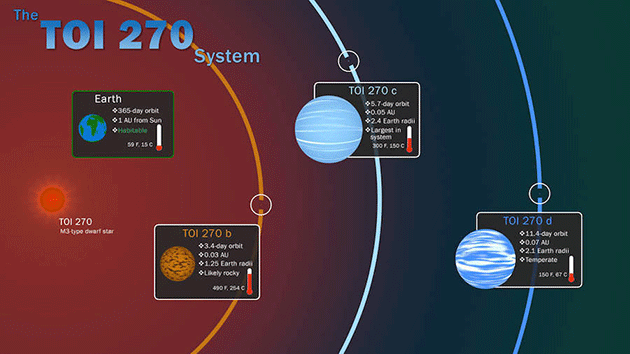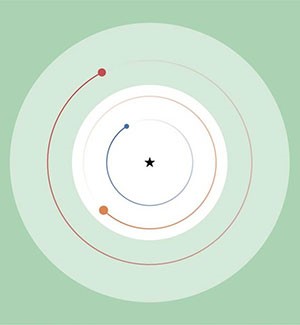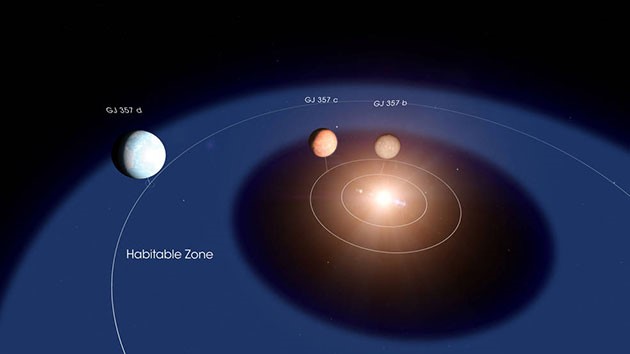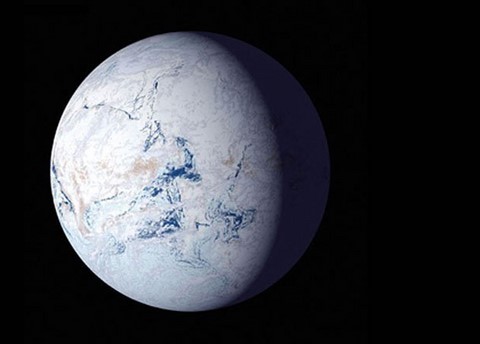Newly discovered close exo-planets (and Life on a Snowball)
The TOI 270 System: three new exo-planets 73 light-years away

CAMBRIDGE (USA) – With the help of NASA’s space telescope TESS (successor to KEPLER), astronomers have just discovered three planets circling Star TOI-270, which is only 72 light-years away. Even though none of the three seem to fulfil the conditions necessary for supporting life as we know it, this system still harbors considerable potential for the development of life.
The star itself is an unusually inactive, that is, quiet Red Dwarf. It is circled by at east three planets which have been discovered by TESS: one rocky planet (TOI-270b), which is just a little bit bigger than our Earth, and two so-called Sub-Neptune, or Super-Earth (TOI-270c und TOI-270d), which are about twice the size of our planet.
While none of the three is circling the star within the classical so-called habitable zone, in which, because of mild temperatures, water can exist in liquid form and therefore provide a basis for life as we know it, the discoverers of the planetary trio around TOI-270 are enthusiastic about their find and its potential for life-friendly environments.
As the team surrounding Maximilian Günther of the Kavli Institute for Astrophysics and Space Research of the Massachusetts Institute of Technology (MIT) is presently explaining in the scientific magazine Nature Astronomy, the inner-most rocky planet (TOI-270b) is 1.25 times bigger than our Earth and takes 3.4 days to circle its star. But, although the star is significantly smaller and cooler than our Sun, the distance is still too short for water to be able to flow on its surface. The two Sub-Neptunes are 2.42 and 2.13 times as large as Earth and circle the star in 5.7 and 11.4 days respectively. So that the outer atmosphere of the smaller one of the two could harbour life-friendly temperatures, but the planet itself is wrapped in an extremely dense atmosphere, heated by a greenhouse effect, and rather resembles our own Venus. Moreover, the astronomers around Günther surmise that all three planets are locked in rotation with their star – meaning that (like our own Moon with regard to Earth), they always turn the same side to it. This, too, makes life-friendliness more problematic.
Yet the system remains exciting from an astrobiological point of view.
First of all, TOI-270 is an older Red Dwarf, which is considerably less active than other Red Dwarves which are relatively close to us and it produces far fewer solar eruptions than these, the deleterious radiation storms of which can negatively affect unprotected life on the planets circling it, or render it impossible.
Also the star is only 73 lightyears away from us, which means that it is relatively bright and easy to observe and to analyze.
All three planets are circling the star on a level orbit with regard to Earth, so that they darken minimally the star’s light at each passage, and astronomers are able to study their atmosphere when the light of the star shines through them at the occasion of transits. Thanks to this, the researchers hope to gain more insight in the processes through which the various planetary systems come into being and to answer questions about why some planets are small and rocky, and others large and gaseous. Such a study cannot be carried out with the planets at hand in our own solar system, because the planetary class of the sub-Neptune, Super-Earth planets, which represents a transition between rocky planets and gaseous ones, is absent in our solar system.
Moreover, all three planets circle their star in resonant orbits, with orbits showing a pattern of gravitational resonance: every time that the innermost planet (TOI-270b) completes five orbits around its star, the middle planet (TOI-270c) completes three – there is therefore a 5:3 relation of resonance between the two planets. The same is the case between the middle planet and the outermost one (TOI-270d), which circle the star in a resonance relation of 2:1.
This means that scientists will be not only be able to study the dynamics of the planets in relation to each other, but the existing resonance patterns could lead them on the way of the discovery of other possible planets, which might circle the star at a greater distance but which have not been discovered so far because of longer orbiting times and differently inclined orbital planes.
And that is where the search for possible life in the system surrounding TOI-270 promises to become really thrilling, for the habitable zone reaches well beyond the planets already known. Planets which circle the star “far out” could well be doing so within the life-friendly zone.
And despite the fact that the currently outermost planet (TOI-270d) is not itself life-friendly, it could possess moons on which life could be possible.
“This system is really exciting and for us researchers, it is like some kind of a laboratory, where so much research can be taken on,” says Günther. “We now have many small pieces which can be assembled to form a bigger picture.”
Orbital diagram of the planets hitherto known to circle TOI-270. The classic "habitable zone" is in dark green, the "extremophile inhabitable zone" (within which extremely resistant microbes could exist) is in light green.
© Günther et al., Nature Astronomy, 2019

Andreas Mueller, July 31, 2019
Translated from the German by Anne-Marie de Grazia
Go to the original article in Grenzwissenschaft-aktuell
The GJ357 System: three new exo-planets 32 light years away

TENERIFFE - In the process of trying to confirm the findings of an Earth-like planet which has been discovered by the planet-seeker space telescope “TESS” around the star GJ357, which is only 32 light-years distant from Earth, astronomers have found within the same system two additional planets. One of them circles the star within the life-friendly zone.
GJ 357 is a red dwarf of the type M, which has about one third of the mass of our Sun and is about 40 percent cooler than our Sun. This solar system is situated in the constellation of Hydra, about 32 light-years away from us.
Last February, NASA’s space-telescope TESS had found there a small exo-planet (GJ 357 b) which turns around the star once in 3.9 days. This planet is 22% bigger than our Earth and circles its star 11 times closer than our Mercury circles our Sun. Which means that on its surface reign seething temperatures of 254 degrees Celsius, which is why the astronomers around Rafael Luque and Enric Pallé of the Institute of Astrophysics of the Canary Islands (IAC) and Diana Kossakowski of the Max-Planck Institute talk about a « hot Earth. »
As the astronomers are currently reporting in Astronomy and Astrophysics, life cannot exist of this planet, yet it represents the third closest planet to its sun discovered so far and one of the best rocky planets suited for studying the composition of an atmosphere from afar – should it turn out that it has one.
In their efforts to confirm the existence of this « hot Earth » by means of Earth-based follow-up observations, the astronomers have discovered two more planets circling the star. The farthest out of the three, (GJ 357 d) could be, if it is confirmed to be a rocky planet, about twice as big as our Earth. Moreover, it is circling its star close to the outer range of the so-called habitable zone, the zone within which a planet must circle its star in order to have moderate surface temperatures which can support water in liquid form – and which is the condition for life, at least such as we know it to exists up to now.
At the distance at which it finds itself, this planet gets about as much energy from its star as does Mars from our Sun in our own planetary system. Should it turn out that the planet possesses a thick atmosphere, it could hold back the heat and make it possible for liquid water to exist on its surface. Without an atmosphere, average temperature would lie around minus 52 degrees celsius. In which case, the planet would be an iced-over world and would hardly be life-friendly according to earthly standards. (See below: Life on a Snowball)
The astronomers have calculated that the mass of GJ 357 d is about 6.1 time the mass of Earth and it needs 55.7 days to circle its sun at a distance which is about 20% of the distance between our Earth and our Sun. Its exact size cannot yet be determined, because of the still unclear composition of the planet.
Should it be found to be a so-called Super Earth, GJ 357D should find a place very high up on the list of hopeful candidates for a close exo-planet with exoterrestrial life.
Andreas Mueller, August 1, 2019
Translated from the German by Anne-Marie de Grazia
Life on a Snowball

TORONTO (Canada) – In the language of astonomers, a snowball planet is one which finds itself totally-iced over, with glaciers and frozen-over oceans from the poles all the way to the equator. On ice-worlds such as these, astrobiologists did not think that life as we know it on Earth would be possible at all, until recently. A new study is now bringing us another picture and kindles hope of finding life on snowballs.
(the picture to the right shows an artist's rendition of a hypothetical snowball planet).
The team around astrophysicist Adiv Paradise of University Toronto is reporting in Journal of Geophysical Research that some icy planets could have land masses close to their equators where temperatures above the freezing point could keep areas there life-friendly.
It is true that the so-called habitable zone designates a distance-zone within which a planet must be orbiting around its star in order for temperatures to allow water to exist in the liquid state, but even on these planets, water can freeze over and turn them into a snowball planet. Many scientists surmise that our own Earth underwent at least once such a trial (in the late Precambrian - the last phase of which ended ca 580 Million years ago) finding itself reduced to an iced-over snowball and that life remained possible only in microbiological form in the depths of the oceans.
„We know that Earth remained life-friendly even through this snowball phase because we know that life existed before it and then after it again,” explains Paradise und explains further: "All life had receded into the oceans during these phases.”
Within the framework of the present study, the scientists want to discover if there can exist surfaces on snowball planets where temperatures could remain life-friendly. They used computer simulations for the purpose and played with diverse climate variables on theoretical snowball planets, varying parameters such as the amount of sunlight and its distribution on the supposed continents.
One particularly interesting component turned out to be carbon dioxide in the atmospheres of the simulated snowball worlds, because carbon dioxide has the ability to retain heat and can keep a planet warm and keep it from cooling over and having its oceans turn to ice.
„Planets turn into snowballs when their atmospheric carbon dioxide values drop too severely as a consequence of a combination of rains and erosion” explains Paradise. „Water absorbs carbon dioxide and changes it to carbonic acid which then interacts with surface rock during the latter’s erosion. This mutual reaction then breaks up carbonic acid and binds it with minerals which then again are flushed into the oceans and end up in storage at the bottom of the oceans.”
Up to now, scientists had surmised that this removal of carbon dioxide from the atmosphere would be interrupted during snowball phases, because all the surface water froze.
But the new simulations show that some snowball planets continue to lose atmospheric carbon dioxide even after they have been frozen up all over. This again shows that these planets dispose of some not entirely frozen land masses above which, and of the surface of which, rains still occur, allowing water to continue to flush out carbon dioxide from the atmosphere, and so to keep up the processes described above.
Some of these simulated “warmer” snowball planets displayed land masses which remained warm enough to maintain some water in liquid form and remain life-friendly, despite the fact that the remaining surface was frozen from the poles to the equator. Simulations show that some of these life-friendly land masses in the interior zones of the continents can maintain temperatures up to 10 degrees above zero Celsius. This is considerably warmer than the lowest temperatures of ca minus 20 degrees Celsius in which life as we know it can maintain itself over long periods.
The results of the studies show also, however, that earth-like planets having gone in a snowball phase can remain trapped in it: up to now, scientists had surmised that prolonged snowball phases could be ended by an increase in carbon dioxide released by volcanic activity. As it turns out, weathering processes can draw enough carbon dioxide out of the atmosphere to compensate for this volcanic emission of carbon dioxide and generate a negative feedback loop which prevents the planet from ever thawing up again.
Finally, the study shows that the limits between a life-friendly and a life-adverse planet need not be set following our own geological prejudices, and that these limits are in fact blurring right before our very eyes.
Andreas Mueller, August 4, 2019
Translated from the German by Anne-Marie de Grazia
Go to the original article in grenzwissenschaft-aktuell

